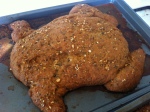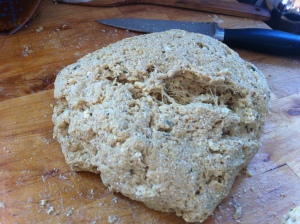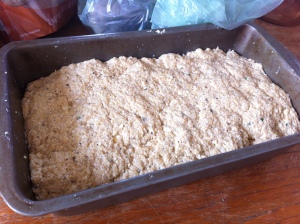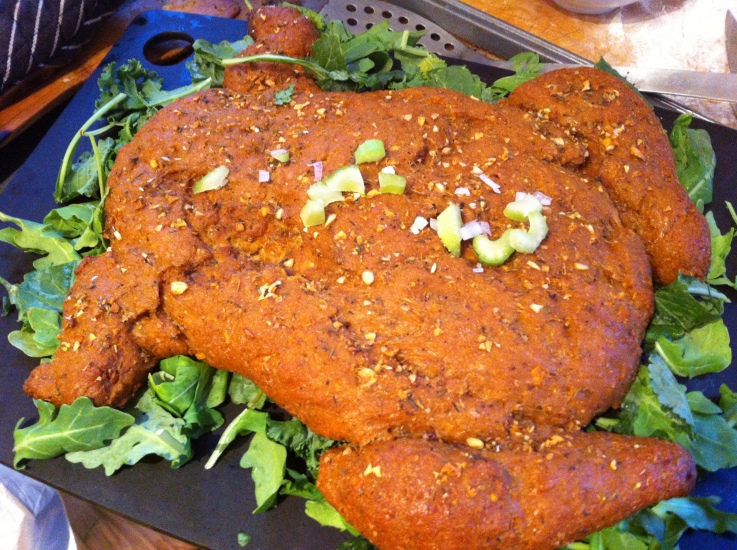 Meatless meat, or how to make flour into turkey
Meatless meat, or how to make flour into turkey
Thanksgiving is one of my favorite holidays. My general philosophy and the motto of this spectacular holiday is proudly displayed on a magnet on my fridge: “Love people. Cook them tasty food.” To me, Thanksgiving is a chance to get all my favorite people in one place and have an excuse to really go all out with the cooking. I love spending all day in the kitchen, jumping from dish to dish, and this year’s dinner was definitely an all-day affair, at my house and everyone else’s–all my guests showed up with amazing food as well, proving once again that I have excellent taste in friends. (I’m really just super lucky that they’re all such good cooks. And, you know, fun to be around. But mostly because of the cooking.) The spread included roasted brussel sprouts and root vegetables, mushroom gravy, poppy-seed-encrusted butternut squash salad, ricotta-walnut zucchini roll-ups, quinoa with pecans and cranberries, chard quiche, mashed potatoes with fresh rosemary, twice-baked sweet potatoes, and, of course, dessert: pecan pie, marionberry pie, pumpkin pie, pumpkin chocolate chip bread, and salted caramel ice cream. And all of it was homemade. I’m pretty spoiled when it comes to food.
All of this amazing food was evidence that Thanksgiving can be just as good when it’s vegetarian, but I decided that the first Thanksgiving hosted at my place needed a turkey. Enter seitan. For those of you who don’t frequent the fake meat section of the grocery store, seitan is a gluten-based meat alternative. Like tofu, it is high in protein and can be cooked in a variety of ways–I’ve had everything from seitan steak to seitan sausage, and I decided it was time for seitan turkey.
We’ve talked about gluten before when we were talking about bread. In addition to being the part of wheat that some people have trouble digesting, gluten is the main structural component of most flour-based creations. As we talked about before, the long glutenin proteins have sulfur-containing cyseine units on both ends, and these bond to other glutenin ends to create a strong, interconnected network. In bread, this makes a loaf hold its shape and gives it the springiness and solidity that we look for.
Seitan is based on the same basic concept. Using gluten instead of whole flour means that the relevant proteins are more concentrated and the final product is even firmer. Bread also uses yeast to introduce air bubbles for a light and airy texture, while seitan in its most basic form is really just gluten and water. The process is simple. Mixing the gluten with water starts the process of forming a strong glutenin network, and kneading it aligns the long protein chains so that the result is more ordered and stronger. The texture at this point is springy but solid, but it’s still pretty slimy. Heating it removes water, leaving the final product less sticky and drier. You can cook it in a number of ways, depending on what you’re looking for. This time I baked it, but I’ve also carved it into small strips and simmered them to cook them through, then fried them for texture.
Because seitan only requires gluten and water to get the texture right, the interesting part is really everything else you add. I’ve used vegetable broth instead of water to add some more flavor, and this time I used tofu and garbanzo beans blended into a paste in the liquid part as well. They add protein and flavor, and I really liked the result. They also dilute the gluten network, meaning that the web can’t be as tight. When you’re eating it, this means that the tofu-added seitan is a little softer and not as chewy as other seitan. As far as flavor goes, I tend to throw in everything but the kitchen sink. My batches of seitan usually have a whole head of garlic, and this guy also had an onion blended with the tofu and beans. Throw in spices you like in large quantities, and it will probably taste delicious. The first time I made seitan, I was nervous about adding too much spice because it’s hard to taste (you want to mix the spices with the dry gluten so that they distribute well–it’s a lot harder to stir once you add the liquid and the gluten network starts to form), but it needs it, trust me. I have some guidelines below, but this is an excellent chance to play around with different combinations. Go crazy!
Seiturkey
I’ve made seitan with just vegetable broth instead of the blended tofu and beans I use here, which needs about a cup of water for every cup of gluten (PPK has a great basic seitan recipe here). No matter what you’re using for liquid, nutritional yeast flakes (which you can get at Whole Foods or similar grocery stores), garlic, and soy sauce are great flavor staples that will keep your masterpiece from tasting like, well, flour.
I adapted this from Whisk Flip Stir, and someone who commented that garbanzo beans would be even better than garbanzo bean flour. The spices are approximate. When I made this, three of us were running around the kitchen throwing things in. Feel free to adapt however you like. The original recipe uses poultry seasoning (1 T.), which would probably make it taste more like turkey.
Yield: one turkey. Or one loaf pan, if you’re not feeling sculpturally inclined
2 c. gluten (you can get Bob’s Red Mill Vital Wheat Gluten at most grocery stores)
1/2 c. nutritional yeast flakes
1 head garlic, minced
1 t. salt
2 t. pepper
1 t. cumin
1 t. paprika
1/2 t. thyme
1/2 t. oregano
1/2 t. cayenne
1 package firm or extra-firm tofu, drained
1 1/2 c. garbanzo beans
1/2 c. water
2 T. Better Than Bouillon (or replace the water with your favorite veggie stock, thicker is better to give the most flavor)
1 onion, coarsely chopped
1/4 c. soy sauce
1 T. olive oil
The assembly is pretty ridiculously simple. Mix all of the dry ingredients (for our purposes, onion is a wet ingredient) in a big bowl. Blend the wet ingredients until smooth, then stir the wet into the dry. It should get pretty hard to stir, so just pick it up and knead it with your hands. Continue to knead for 5 minutes. The dough will be wet and firm.
This is when you get to let out your inner artist! We shaped drumsticks, wings, and a body, then assembled it on a greased baking tray. The combination of thick and thin parts meant that you got some different textures–the wings and the small ends of the dumsticks were crunchy and chewy, while the center of the body (the breast, of course) was more tender. I liked having the variety, but make sure that none of it is too thick or it won’t get cooked.
You can also just put it in an oiled loaf pan. It won’t be nearly as cute, but it’s still delicious.
Basting broth
1 c. water
2 t. Better Than Bouillon (or other veggie broth)
1 T. olive oil
4 cloves garlic, minced
1/2 t. pepper
1/4 t. cumin
1/4 t. thyme
Mix everything together, making sure the Better Than Bouillon dissolves. Pour about 1/4 c. over the turkey/loaf before putting it in the oven and after about half an hour.
Bake the turkey/loaf at 350 degrees F for an hour. The outside should be brown, and it should feel firm when you press on it. Let it cool at least 15 minutes, then carve away!
Much as I loved our turkey centerpiece on Thanksgiving, the leftovers were just as good. We fried strips for breakfast for about the next week, although it’s surprising it lasted that long! It would also be great cut up in soup, fried and in tacos, or really in just about any way you would use meat. One of the beautiful things about homemade seitan is that you can tailor the spices to your eventual use, giving you something different every time.




